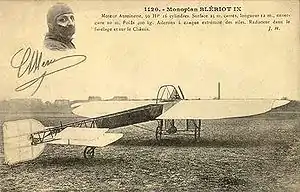| Blériot IX | |
|---|---|
 | |
| Role | Experimental aircraft |
| Manufacturer | Louis Blériot |
| First flight | 1908 |
| Number built | 1 |
The Blériot IX was an unsuccessful early French aeroplane built by Louis Blériot. Encouraged by the ever-increasing altitude, distance, and duration of flights with the Blériot VIII in 1908, he built a new machine along the same general lines, but heavier and with a more powerful engine. The Blériot IX was exhibited at the Paris Motor Show in December 1908, but the design proved overweight and could not be made to leave the ground.
Development
The aircraft was a wire-braced mid-winged monoplane with conventional landing gear and an open cockpit. The aircraft used two large vertically mounted steam radiators on each side. A unique feature for the time was an all-metal ground-adjustable four-blade propeller installation.[1]
Specifications
General characteristics
- Crew: one pilot
- Length: 12.00 m (39 ft 4 in)
- Wingspan: 9.00 m (29 ft 6 in)
- Wing area: 25 m2 (269 sq ft)
- Gross weight: 450 kg (990 lb)
- Powerplant: 1 × Antoinette 16V , 48 kW (65 hp)
References
- ↑ "A glimpse into the past". Air Progress. 40/11 (78): 16. November 1978.
External links
Further reading
- Taylor, Michael J. H. (1989). Jane's Encyclopedia of Aviation. London: Studio Editions. p. 161.
- Devaux, Jean; Marani, Michel (May 1989). "Les Douze Premiers Aéroplanes de Louis Blériot". Pegase (in French) (54).
Wikimedia Commons has media related to Bleriot IX.
This article is issued from Wikipedia. The text is licensed under Creative Commons - Attribution - Sharealike. Additional terms may apply for the media files.